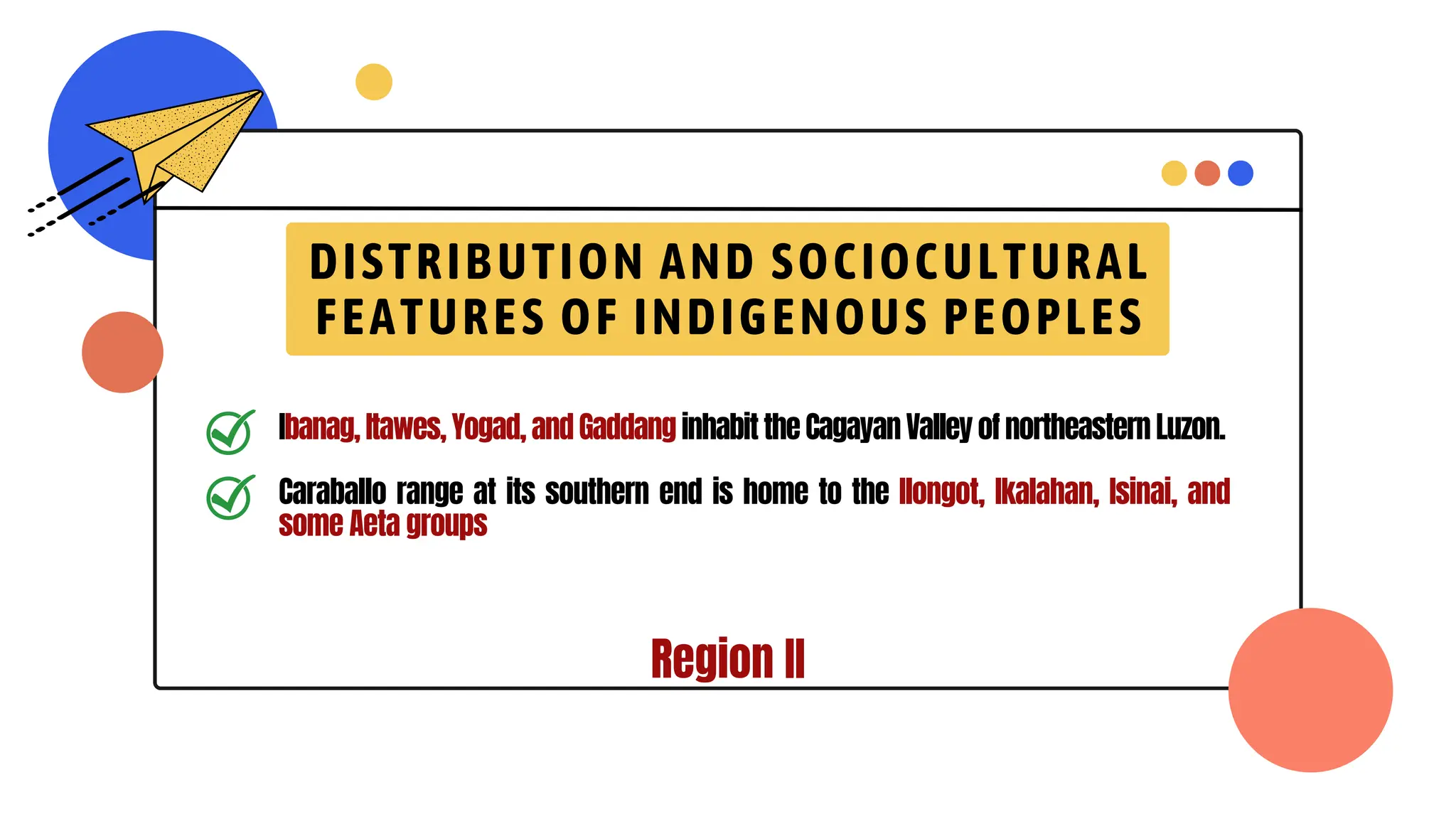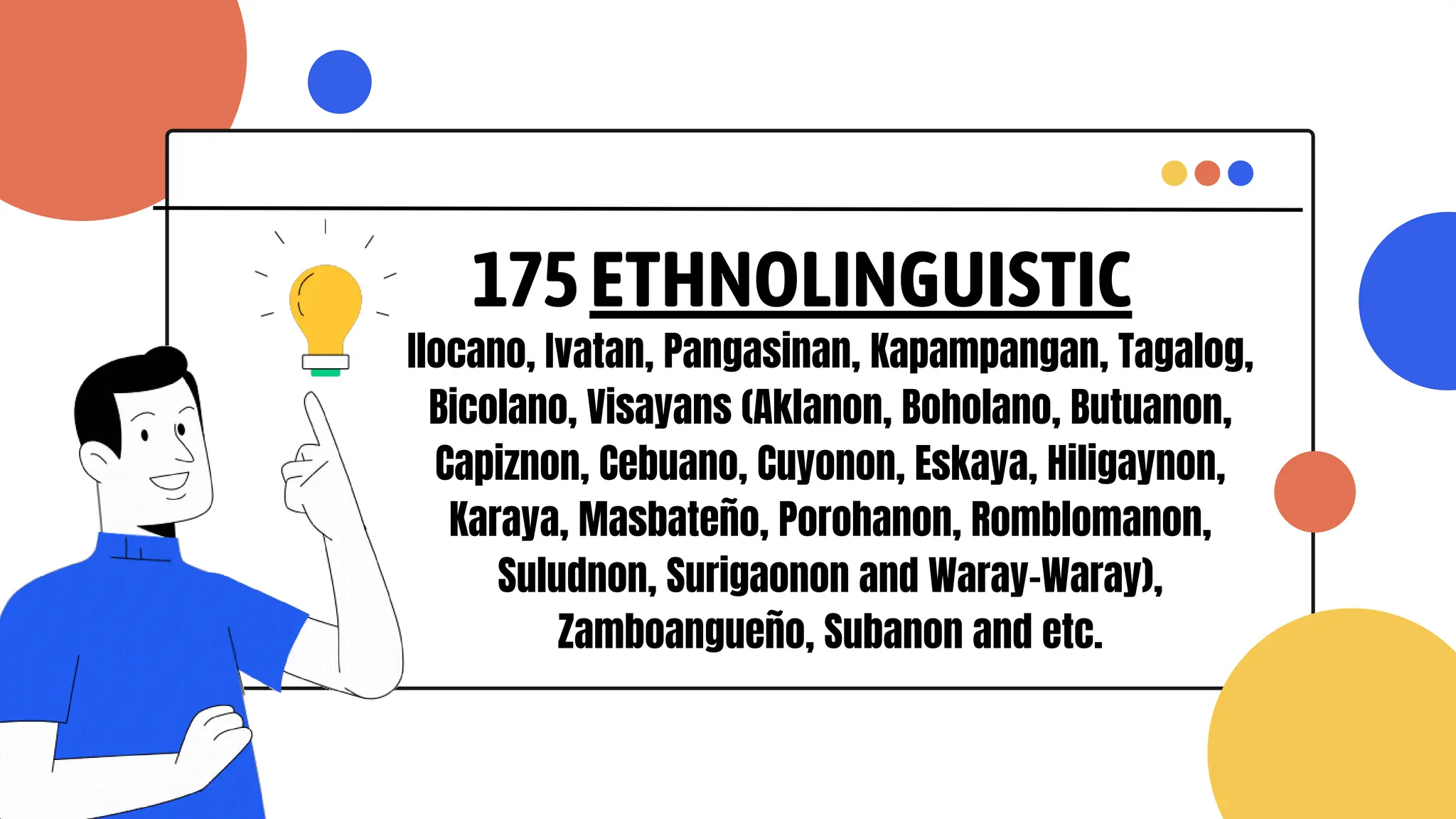The document discusses indigenous communities in the Philippines. It defines indigenous peoples as descendants of those inhabiting a country prior to conquest or colonization who maintain distinct social, cultural and political identities. There are estimated to be between 12-17 million indigenous peoples belonging to over 100 ethnolinguistic groups across the Philippines. The majority live in Mindanao, with others scattered throughout Luzon, the Visayas islands and Palawan. The document outlines the geographic distribution and sociocultural characteristics of various indigenous communities.














![Characteristics of indigenous peoples are observed:
ICCs/IPs [indigenous cultural communities/indigenous peoples] shall
likewise include peoples who are regarded as indigenous on account of
their descent from the populations which inhabited the country, at the time
of conquest or colonization, or at the time of inroads of nonindigenous
religions and cultures, or the establishment of present state boundaries,
who retain some or all of their own social, economic, cultural and political
institutions, but who may have been displaced from their traditional
domains or who may have resettled outside their ancestral domains. IPRA,
Chapter II, Section 3h).](https://image.slidesharecdn.com/prelimlessons-240315072251-090337ee/75/Who-are-Indigenous-Peoples-and-its-behavior-15-2048.jpg)






![SEVEN ETHNOGRAPHIC AREAS
Region I and CAR
Region II
The rest of Luzon (Regions III, IV [part], and V)
Island groups (Regions IV [part], VI, VII, and VIII)
Northern and Western Mindanao (Regions IX [Zamboanga Peninsula] and X
[Northern Mindanao
Southern and Eastern Mindanao (Regions XI [Davao Region] and XIII [Caraga])
Central Mindanao (Region XII [SOCCSKSARGEN])](https://image.slidesharecdn.com/prelimlessons-240315072251-090337ee/75/Who-are-Indigenous-Peoples-and-its-behavior-22-2048.jpg)



![DISTRIBUTION AND SOCIOCULTURAL
FEATURES OF INDIGENOUS PEOPLES
Seven Mangyan groups in the island of Mindoro:
the Iraya, Alangan, Tadyawan, Tao-Buhid, Buhid,
Hanunoo, and Gubatnon.
Island groups (Regions IV [part], VI, VII, and VIII)](https://image.slidesharecdn.com/prelimlessons-240315072251-090337ee/75/Who-are-Indigenous-Peoples-and-its-behavior-26-2048.jpg)
![DISTRIBUTION AND SOCIOCULTURAL
FEATURES OF INDIGENOUS PEOPLES
In the interior foothills and remote coastal areas of Panay and Negros Islands are the
Sulod and the Ati.
In the island of Palawan, the Tagbanua are found in northern and central areas.
The Batak are found in small pockets north of Puerto Princesa City and in
northeastern Palawan.
Island groups (Regions IV [part], VI, VII, and VIII)](https://image.slidesharecdn.com/prelimlessons-240315072251-090337ee/75/Who-are-Indigenous-Peoples-and-its-behavior-27-2048.jpg)
![DISTRIBUTION AND SOCIOCULTURAL
FEATURES OF INDIGENOUS PEOPLES
The Palawanon are in the southern part of Palawan near Brooks Point.
the Mangyans of Mindoro; the Sulod and Ati of Panay; the Aeta groups in Negros
Island;
Batak, Cuyonen, Palawanon, and Tagbanua of Palawan
Island groups (Regions IV [part], VI, VII, and VIII)](https://image.slidesharecdn.com/prelimlessons-240315072251-090337ee/75/Who-are-Indigenous-Peoples-and-its-behavior-28-2048.jpg)
![DISTRIBUTION AND SOCIOCULTURAL
FEATURES OF INDIGENOUS PEOPLES
Along the hinterlands and coastal lowlands of the Zamboanga peninsula live the
Subanen
northern Mindanao, particularly on the plateaus of Bukidnon, are the indigenous
peoples who call themselves Higaonon meaning “mountain dwellers.”
Northern and Western Mindanao (Regions IX [Zamboanga
Peninsula] and X [Northern Mindanao]
highlands of central Mindanao, particularly along the mountainous slopes of the
provinces of Davao, Bukidnon, and Cotabato are the Bagobo](https://image.slidesharecdn.com/prelimlessons-240315072251-090337ee/75/Who-are-Indigenous-Peoples-and-its-behavior-29-2048.jpg)
![DISTRIBUTION AND SOCIOCULTURAL
FEATURES OF INDIGENOUS PEOPLES
upper headwaters of the Davao, Tinanan, and Kulaman rivers are the Manuvu,
Matigsalug, Ata, and others
In the coastal areas along Davao Gulf and interior hinterlands of southeastern
Mindanao are the Mandaya, Coastal Bagobo, Agusan Manobo, and Ata.
Southern and Eastern Mindanao (Regions XI [Davao Region]
and XIII [Caraga]) Central Mindanao (Region XII
[SOCCSKSARGEN])](https://image.slidesharecdn.com/prelimlessons-240315072251-090337ee/75/Who-are-Indigenous-Peoples-and-its-behavior-30-2048.jpg)




